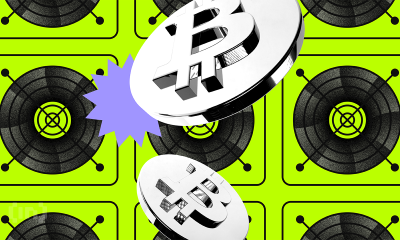Market
DePin Sector’s Challenges and Growth Opportunities Revealed

Lately, decentralized physical infrastructure networks (DePins) are strongly emerging as a crypto narrative. HashKey Capital, a blockchain investment firm, has spotlighted over 1,000 DePin projects.
These DePin projects collectively generate an impressive $14 million in annual recurring revenue. They span fields like the Internet of Things (IoT), artificial intelligence (AI), wireless coverage, and data management, aiming to democratize technology and bolster competition.
What Are the Challenges in the DePin Sector?
Despite their potential, DePin projects encounter notable obstacles. A key issue is the proliferation of similar initiatives and competition from established Web2 companies, which threatens to fragment the market and weaken the impact of new DePin entities.
“The fairly nascent DePin sector also makes it arduous to generate demand from retail consumers and Web2 enterprises who lack the awareness and trust in the reliability of the sector,” HashKey Capital wrote.
For instance, in the mapping sector, projects such as Hivemapper and Natix Network compete directly with giants like Google Maps. Moreover, capturing and retaining user interest proves challenging in a market largely unfamiliar with decentralized solutions.
Read more: What Is DePIN (Decentralized Physical Infrastructure Networks)?
To overcome these challenges, HashKey Capital recommends that DePin projects diversify their demand streams beyond the Web3 space. They should also focus on user experience as a key differentiator.
However, DePins also faces high upfront costs, complex supply chains, and stringent regulatory environments. In an interview with BeInCrypto, Daniel Wang, co-founder of Aethir, discussed the regulatory challenges of DePin.
“DePIN projects face a web of regulatory challenges, encompassing securities regulations, anti-money laundering (AML) compliance, Know-your-customer (KYC) requirements, and data privacy laws. The uncertainty extends to taxation, further complicating matters,” Wang told BeInCrypto.
He stressed the need for DePins to remain adaptable and compliant across various legal frameworks, which differ significantly by jurisdiction.
“By advocating for policies that foster innovation while ensuring adherence to local laws, DePins can thrive within a secure and innovative environment,” Wang stated.
DePin Growth Opportunities
Despite these challenges, DePins holds immense potential for transformative impact, particularly in low to middle-income countries. HashKey Capital identifies these regions as key growth areas, driven by their need for affordable and accessible infrastructure solutions. By decentralizing data management and utilizing underutilized resources, DePins can significantly reduce digital infrastructure costs.
For instance in developing countries of Africa, DePin can empower local communities by enabling individuals and businesses to monetize spare computing and storage capacities.
“DePin enables local communities to participate more fully in the digital economy and opens up new avenues for financial opportunity. Additionally, DePins facilitate the creation of a more efficient and affordable internet infrastructure. By reducing the reliance on individual data centers and promoting decentralized networks, DePINs lower costs and improve internet accessibility in underserved areas,” Wang explained.
Additionally, DePins’ flexibility allows for rapid deployment and community engagement through node sales, securing long-term community support, and raising development funds.
Looking ahead, sectors such as AI will significantly grow due to the increasing computational demands of large language models. DePins unify idle resources across a blockchain, addressing potential demand-supply mismatches and optimizing resource utilization.
Moreover, according to Statista, the IoT market is expected to surge to $1.559 trillion by year-end, with a compound annual growth rate of 10.5% from 2024 to 2029. Hence, DePins are well-positioned to capture a substantial market share.
Read more: Top 12 Crypto Companies to Watch in 2024

Indeed, by fostering user-owned economies where privacy and data control are prioritized, DePins could redefine technology consumption and governance.
Disclaimer
In adherence to the Trust Project guidelines, BeInCrypto is committed to unbiased, transparent reporting. This news article aims to provide accurate, timely information. However, readers are advised to verify facts independently and consult with a professional before making any decisions based on this content. Please note that our Terms and Conditions, Privacy Policy, and Disclaimers have been updated.
Market
Report Alleges Massive Meme Coin Sniping on Pump.fun

According to a new report from Pine Analytics, token deployers on Pump.fun systematically funded sniper wallets to buy their own meme coins. This impacted over 15,000 token launches on the platform.
These sniper wallets operated primarily during US trading hours, executing standardized, profitable strategies. Unrelated bot activity obscures their behavior, making it extremely difficult to isolate these wallets—and they can readily adapt to new countermeasures.
Snipers Roam Free on Pump.fun Meme Coins
Pump.fun has remained one of the most popular meme coin launchpads on Solana despite persistent controversies and other criticism.
However, Pine Analytics’ new report has uncovered a new controversy, discovering systematic market manipulation on the platform. These snipes include as much as 1.75% of all launch activity on Pump.fun.
“Our analysis reveals that this tactic is not rare or fringe — over the past month alone, more than 15,000 SOL in realized profit was extracted through this method, across 15,000+ launches involving 4,600+ sniper wallets and 10,400+ deployers. These wallets demonstrate unusually high success rates (87% of snipes were profitable), clean exits, and structured operational patterns,” it claimed.
Solana meme coin deployers on Pump.fun follow a consistent pattern. They fund one or more sniper wallets and grant them advance notice of upcoming token launches.
Those wallets purchase tokens in the very first block and then liquidate almost immediately—85% within five minutes and 90% in just one or two swap events.

Pump.fun meme coin developers exploit this tactic to create the appearance of immediate demand for their tokens. Retail investors, unaware of the prior sell‑off, often purchase these tokens after the snipe, giving developers an unfair advantage. This constitutes market manipulation and erodes trust in the platform.
Pine Analytics had to carefully calibrate its methods to identify genuine snipers. Apparently, 50% of meme coin launches on Pump.fun involve sniping, but most of this is probably bots using the “spray and pray” method.
However, by filtering out snipers with no direct links to developer wallets, the firm missed projects that covered their tracks through proxies and burners.
In other words, the meme coin community does not have adequate defenses against systematic abuse on Pump.fun. There are a few possible ways that the platform could flag repeat offenders and sketchy projects, but adaptive countermeasures could defeat them. This problem demands persistent and proactive action.
Unfortunately, it may be difficult to enact such policies. Meme coin sniping is so systematic that Pump.fun could only fight it with real commitment.
Analysts think that building an on-chain culture that rewards transparency over extraction is the best long-term solution. A shift like that would be truly seismic, and the meme coin sector might not survive it.
Disclaimer
In adherence to the Trust Project guidelines, BeInCrypto is committed to unbiased, transparent reporting. This news article aims to provide accurate, timely information. However, readers are advised to verify facts independently and consult with a professional before making any decisions based on this content. Please note that our Terms and Conditions, Privacy Policy, and Disclaimers have been updated.
Market
Solana Leads Blockchain Metrics as SOL Momentum Builds

Solana (SOL) continues to show strength across multiple fronts, maintaining a bullish structure on its Ichimoku Cloud chart while gaining momentum in key market metrics. The BBTrend indicator has turned higher again, signaling renewed buying pressure after a brief cooldown.
On-chain activity remains strong, with Solana leading all blockchains in DEX volume and dominating fee generation thanks to the explosive growth of meme coins and launchpad activity. With SOL now trading above a key resistance level, the path is open for further upside—though a loss of momentum could still trigger a retest of lower supports.
Solana Maintains Bullish Structure, but Momentum Faces Key Test
On Solana’s Ichimoku Cloud chart, the price is currently above the Kijun-sen (red base line) but has dipped below the Tenkan-sen (blue conversion line), signaling weakening short-term momentum.
The flattening Tenkan-sen and price behavior suggest possible consolidation or the early stages of a pullback. Still, with the price holding above the Kijun-sen, medium-term support remains intact.
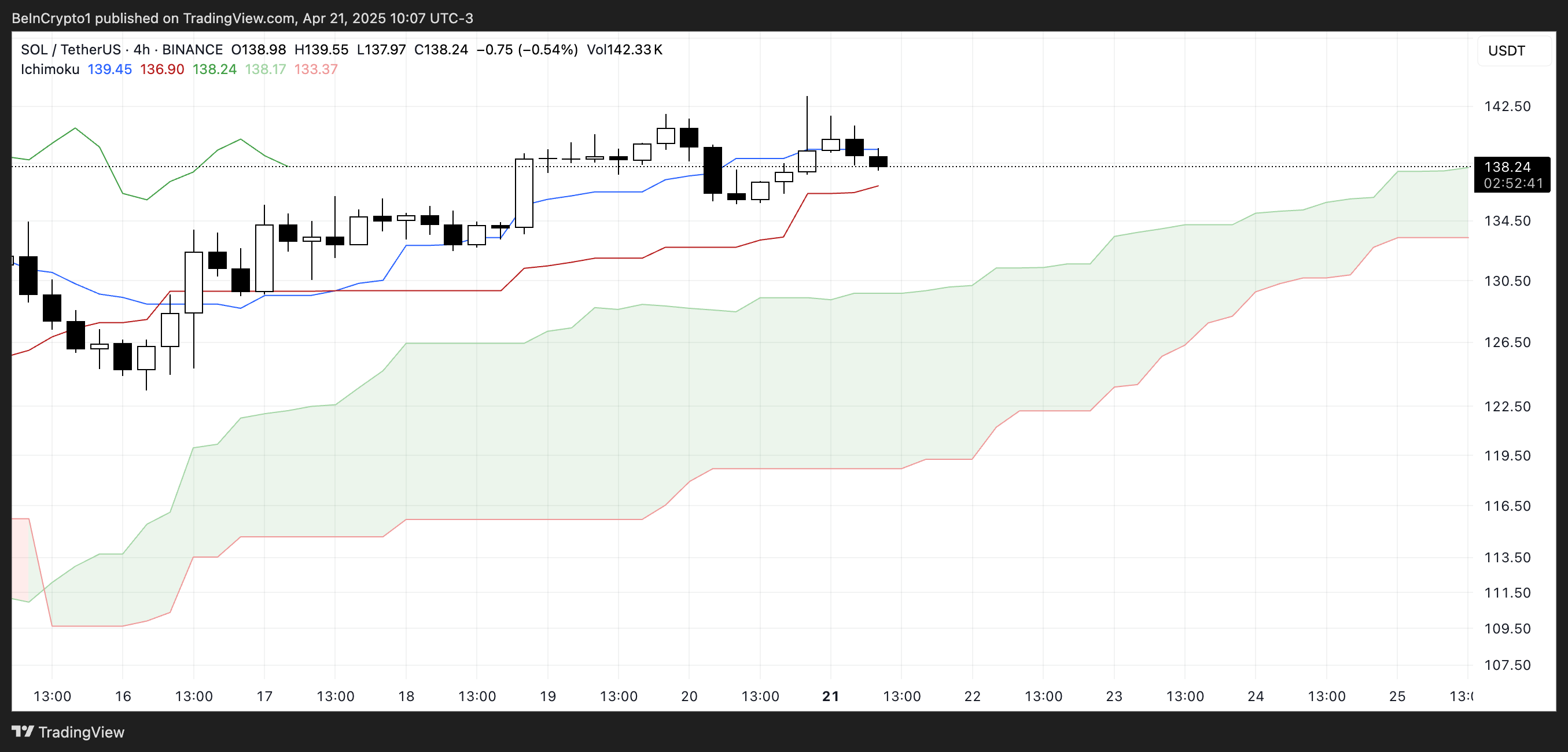
The overall Ichimoku structure remains bullish, with a thick, rising cloud and leading span A well above span B—indicating strong underlying support.
If Solana finds support at the Kijun-sen and climbs back above the Tenkan-sen, the uptrend could regain strength; otherwise, a test of the cloud’s upper boundary may follow.

Meanwhile, Solana’s BBTrend is currently at 6, extending nearly ten days in positive territory after peaking at 17.5 on April 14. The recent increase from 4.26 to 6 suggests renewed bullish momentum following a brief cooldown.
BBTrend, or Bollinger Band Trend, tracks the strength of price movement based on Bollinger Band expansion.
Positive values like the current one point to an active uptrend, and if the BBTrend continues to rise, it could signal stronger momentum and potential for another upward move.
Solana Dominates DEX Volume and Fee Generation as Meme Coins Drive Ecosystem Growth
Solana has once again claimed the top spot among all chains in DEX volume, recording $15.15 billion over the past seven days. The combined total of Ethereum, BNB, Base, and Arbitrum reached $22.7 billion.

In the last 24 hours alone, Solana saw $1.67 billion in volume, largely fueled by its booming meme coin ecosystem and the ongoing launchpad battle between PumpFun and Raydium. Adding to this good momentum, Solana recently surpassed Ethereum in Staking Market Cap.

When it comes to application fees, Solana’s momentum is just as clear. Four of the top ten fee-generating apps over the past week—PumpFun, Jupiter, Jito, and Meteora—are Solana-focused.
Pump leads the pack with nearly $18 million in fees alone.
Solana Breaks Key Resistance as Uptrend Targets Higher Levels, but Risks Remain
Solana has finally broken above its key resistance at $136, flipping it into a new support level that was successfully tested just yesterday.
Its EMA lines remain aligned in a bullish setup, suggesting the uptrend is still intact.
If this momentum continues, SOL price could aim for the next resistance zones at $147 and $152—levels that, if breached, open the door to a potential move toward $179.
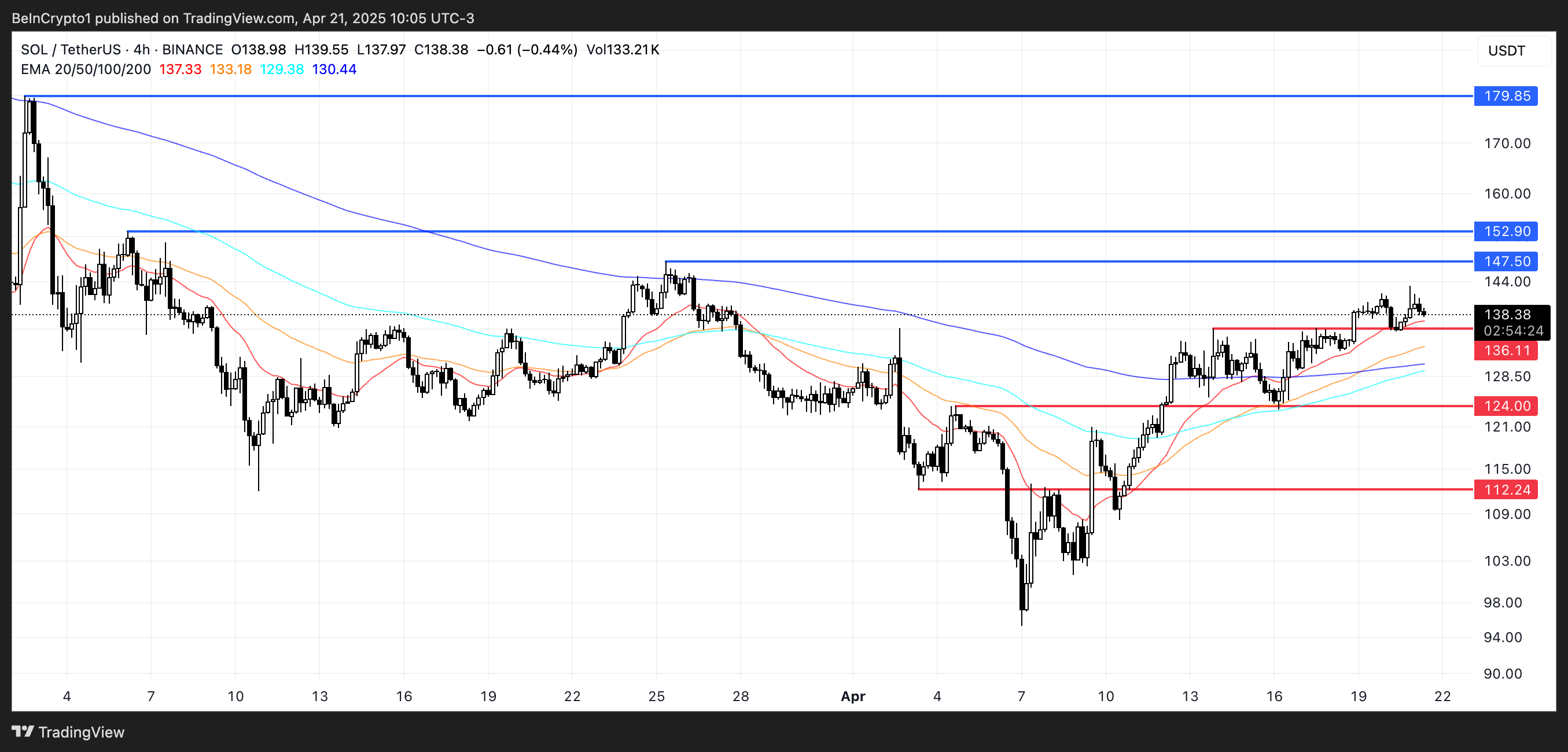
The current structure favors buyers, with higher lows and strong support reinforcing the trend.
However, if momentum fades, a retest of the $136 support is likely.
A breakdown below that level could shift sentiment, exposing Solana to deeper pullbacks toward $124 and even $112.
Disclaimer
In line with the Trust Project guidelines, this price analysis article is for informational purposes only and should not be considered financial or investment advice. BeInCrypto is committed to accurate, unbiased reporting, but market conditions are subject to change without notice. Always conduct your own research and consult with a professional before making any financial decisions. Please note that our Terms and Conditions, Privacy Policy, and Disclaimers have been updated.
Market
Crypto Firms Donated $85 million in Trump’s Inauguration
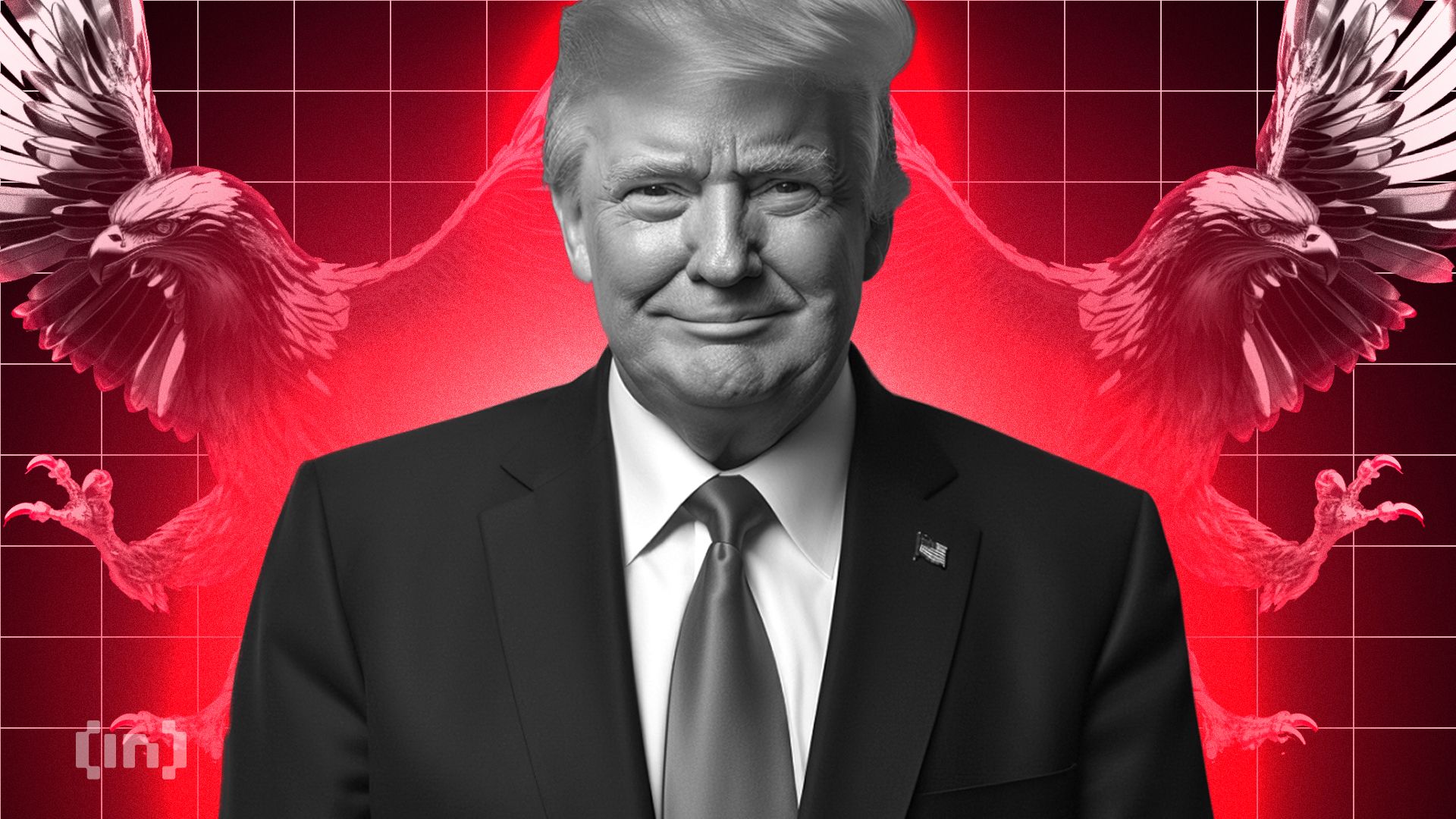
According to a new report, 15 firms and individuals from the crypto industry donated more than $100,000 to President Trump’s Inauguration, totaling over $85 million.
Almost all of these companies apparently received direct or indirect benefits from Trump’s administration. This includes dropped legal proceedings, lucrative business partnerships, participation in Trump’s Crypto Summit, and more.
Crypto Industry Went All-In on Trump’s Inauguration
Since promising to bring friendlier regulations on the campaign trail, Donald Trump attracted a reputation as the Crypto President.
Trump’s Inauguration festivities included a “Crypto Ball,” and several prominent firms made donations for these events. Today, a report has compiled all crypto-related contributions of over $100,000, revealing some interesting facts.

Since taking office, President Trump and his family have been allegedly involved in prominent crypto controversies, and these donations may be linked to several of them.
For example, eight of the donors, Coinbase, Crypto.com, Uniswap, Yuga Labs, Kraken, Ripple, Robinhood, and Consensys, had SEC investigations or lawsuits against them closed since Trump’s term began.
The commission might have dropped its probe against these companies anyway due to its changing stance on crypto enforcement. However, being in the President’s good books likely helped the process.
Further Alleged Benefits for Donors
In other words, nearly half the firms that made donations to Trump’s Inauguration have seen their legal problems cleared up quickly. This isn’t the only regulation-related benefit they allegedly received.
Circle, for example, recently made an IPO after openly stating that Trump’s Presidency made it possible. Galaxy Digital received SEC approval for a major reorganization, a key step for a NASDAQ listing.
Other donors, such as Crypto.com and ONDO, got more direct financial partnerships with businesses associated with the Trump family.
Previously, Ripple’s CEO, Brad Garlinghouse, anticipated a crypto bull market under Trump. Also, XRP, Solana, and Cardano were all unexpectedly included in the US Crypto Reserve announcement.
All three of these companies made major donations to Trump’s Inauguration.
It seems that most of the firms involved got at least some sort of noticeable benefit from these donations. Donors like Multicoin and Paradigm received invitations to Trump’s Crypto Summit, while much more prominent groups like the Ethereum Foundation got snubbed.
Meanwhile, various industry KOLs and community members have already alleged major corruption in Trump’s crypto connections.
While some allegations might lack substantial proof, the crypto space has changed dramatically under the new administration, for both good and bad.
Disclaimer
In adherence to the Trust Project guidelines, BeInCrypto is committed to unbiased, transparent reporting. This news article aims to provide accurate, timely information. However, readers are advised to verify facts independently and consult with a professional before making any decisions based on this content. Please note that our Terms and Conditions, Privacy Policy, and Disclaimers have been updated.
-
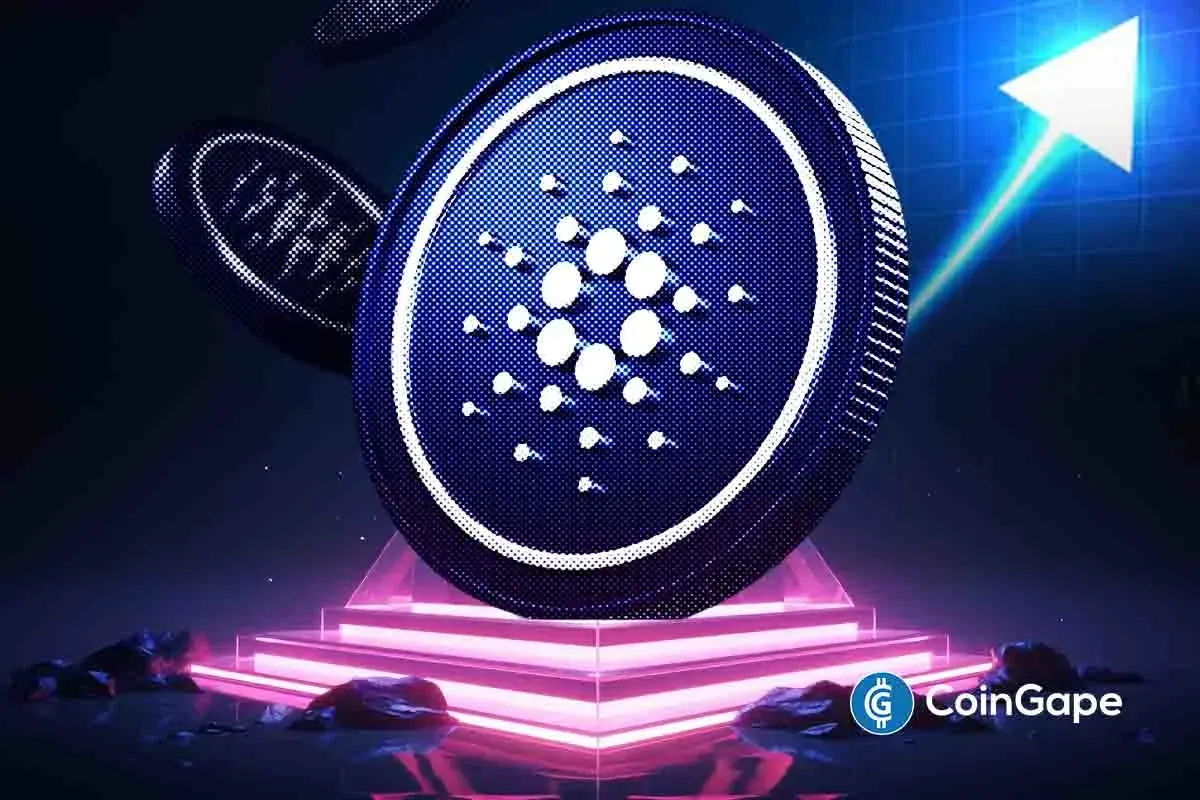
 Altcoin22 hours ago
Altcoin22 hours agoWill Cardano Price Break Out Soon? Triangle Pattern Hints at 27% ADA Surge
-

 Market21 hours ago
Market21 hours agoCircle, BitGo, and Others Eye Bank Charters in US
-

 Ethereum18 hours ago
Ethereum18 hours agoEthereum Analyst Sets $3,000 Target As Price Action Signals Momentum – Details
-

 Market18 hours ago
Market18 hours agoHow Will it Impact OM Price?
-

 Market24 hours ago
Market24 hours agoOptimism, Aztec, and Huma Finance
-

 Market22 hours ago
Market22 hours agoBNB Springs Back From $531 With Unshaken Bullish Conviction
-
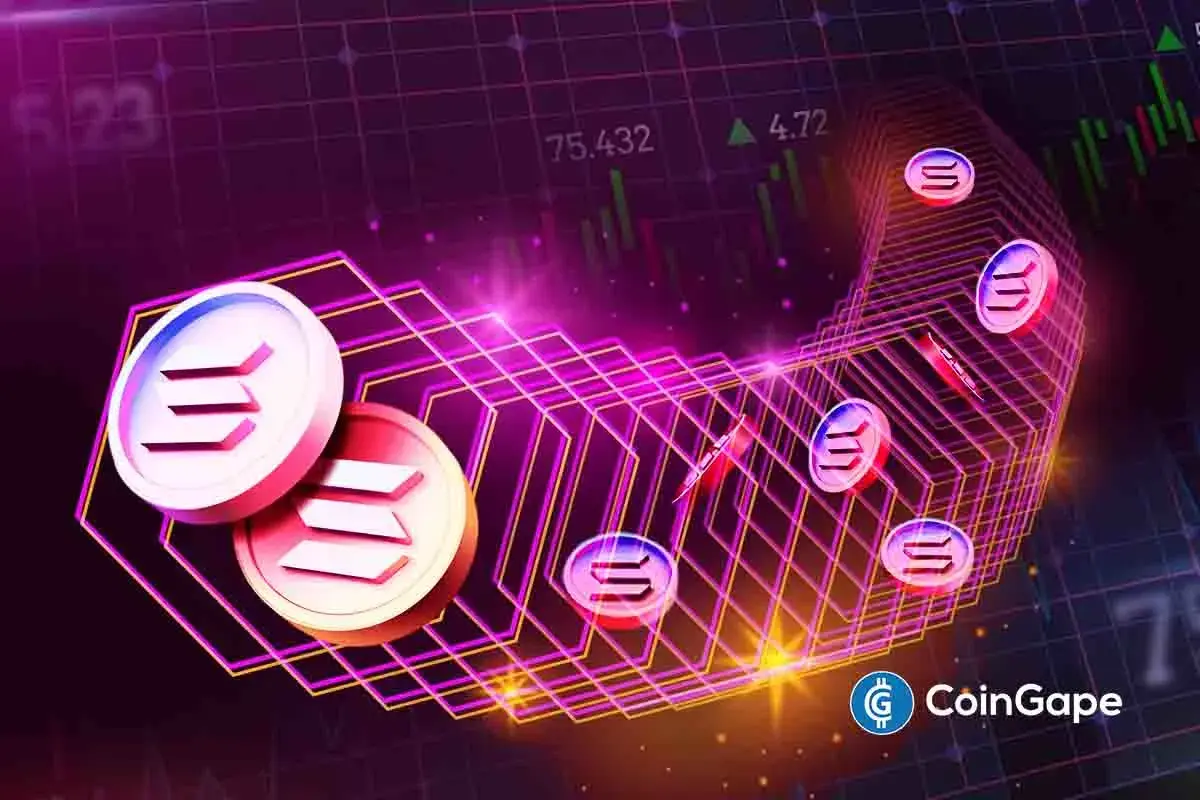
 Altcoin21 hours ago
Altcoin21 hours agoTop Solana Price Levels to Watch in the Short Term
-

 Market20 hours ago
Market20 hours agoPI Token Price Faces Bearish Pressure, Risking a Drop to $0.40








